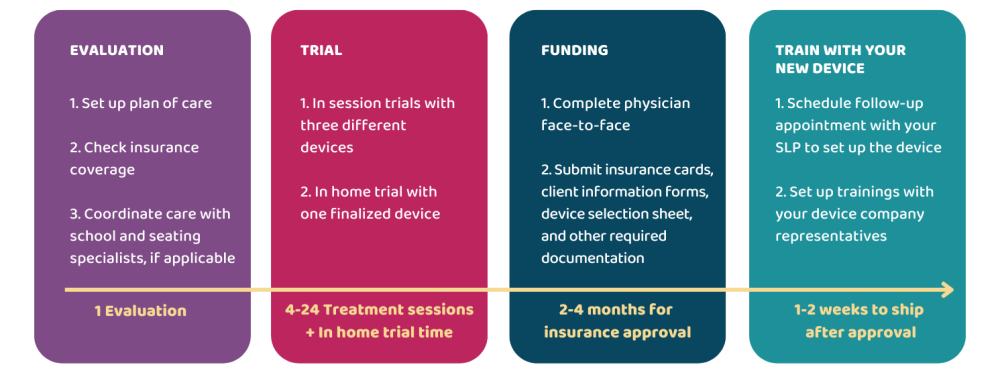What happens after an AAC evaluation?
After an AAC evaluation,
- Results and recommendations for a plan of care will be discussed.
- The plan of care will be set up.
- Once your evaluation is complete, your therapist will work with you to determine a schedule to fit your family’s needs. Oftentimes, 4-24 sessions may be needed to complete the plan of care; however, this will vary based on individual needs. Your plan of care may include an appointment with the occupational therapy team to determine how your child will best access their communication device for functional communication. You can call to schedule at 651-290-8707.
- You should check coverage with your insurance.
- Before your plan of care begins, call your primary and secondary (if applicable) insurance companies to determine coverage for durable medical equipment (speech-generating device). Ask your therapist for information about determining AAC equipment coverage.
- If your insurance does not cover speech-generating devices, work with your caseworker or a social worker to determine alternative funding options.
- Care is coordinated.
- In order to provide the best comprehensive care, discuss the evaluation and plan of care with your child’s school team. Your evaluating therapist will help you fill out a release of information to coordinate care with your child’s school team.
- If your child has alternative seating or positioning needs, your evaluating therapist will help coordinate with a seating specialist to consider device mounting needs.
What does an AAC device trial look like?
An AAC device trial is a two-stage process:
- In-session trials:
- Your speech-language pathologist (SLP) will complete trials with a minimum of 3 different communication devices during your weekly appointments. Devices will be tried across several weeks to determine whether or not they meet your child’s needs. You and your family need to attend these sessions to provide feedback to the therapists and learn how to get around and use the device with your child. If you have positioning needs, different device mounts will be considered. Once in-session trials are complete, your treating therapist will make their recommendation for one trial device and any mounts, if needed.
- In-home extended trial:
- Once you and your therapy team have chosen a device, they will recommend an in-home trial. Your SLP will help you fill out trial information forms to submit to the device company. It may take several weeks or more for you to receive your trial device. Once received, the trial will last between 2 weeks to 3 months depending on your insurance and individual needs. During this time, your SLP will provide training on how to use the device for functional use at home, school, and in your community. They will provide you with forms to write down examples of how your child is using their device to communicate. Insurance companies require this data to demonstrate the use of the device with multiple people and within different environments. Your SLP will contact your child’s school team to ensure the use of the system across settings. Your school will be asked to write down data to demonstrate your child is carrying over their skills.
What do I do after the in-session and in-home trials are completed?
After the AAC device trials are completed,
- Complete funding documents and check insurance coverage.
- Your speech-language pathologist (SLP) will gather the necessary documents and submit them to the device company. Your SLP will work with you to complete these documents. They could include client information forms, copies of insurance cards, equipment selection sheets, AAC report and the doctor’s prescription and face-to-face note.
- Get a prescription from your doctor for the purchase of the AAC system.
- Your SLP will work with you to get the appropriate prescription signed by your doctor.
- The centers for Medicare and Medicaid Services require a copy of the office notes from a face-to-face appointment with your referring provider. The physician must document that you were evaluated and treated for a condition that supports the medical necessity of the AAC device. This face-to-face visit must be within 6 months and the doctor’s notes must mention the need for a communication device (the office notes and the prescription must be completed by the same doctor). Your speech-language pathologist can provide guidance on the visit note requirements.
- Review and submit to Insurance.
- The device company will receive the doctor’s prescription and office notes, then review the packet of forms to ensure all paperwork is completed. Once reviewed, the device company will submit it to insurance. This typically takes 2-4 months to hear back from insurance once all documentation is collected.
- Obtain approval and next steps.
- If approved by your insurance, a representative from the company will contact you to schedule a delivery of equipment. Your insurance company may ask for more information. Additional documentation may need to be provided.
- If you receive a denial from insurance, a representative from the company will contact you. At that time, they may provide additional resources for funding or may ask if you would like to start an appeal. If an appeal is started, you will work with the device company and your SLP to complete the necessary documents to submit an appeal. This process may take several months to complete.
- Train with the device.
- Oftentimes, outpatient speech therapy sessions are recommended after the device is received to work on using the device and programming. Family and school teams are also encouraged to set up training sessions with company representatives.

This information is for educational purposes only. It is not intended to replace the advice of your health care providers. If you have any questions, talk with your doctor or others on your health care team.
If you are a Gillette patient with urgent questions or concerns, please contact Telehealth Nursing at 651-229-3890.
 Home Page
Home Page
